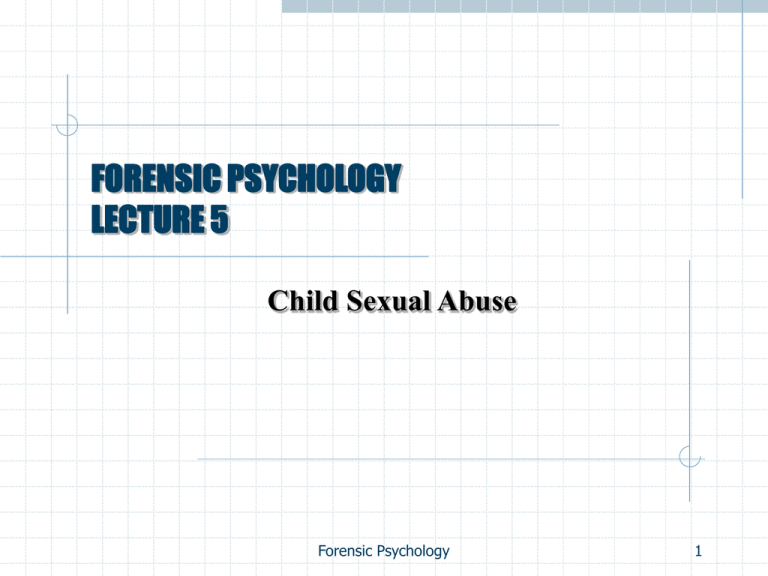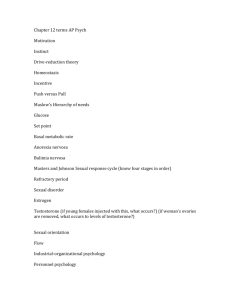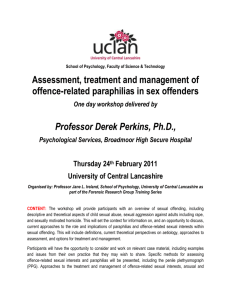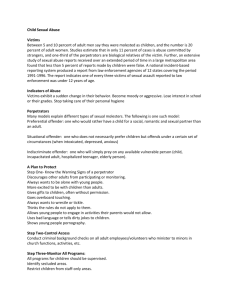
FORENSIC PSYCHOLOGY
LECTURE 5
Child Sexual Abuse
Forensic Psychology
1
Recommended Reading
Department of Health and Children (1999). Children First:
Guidelines For The Protection and Welfare of Children.
(Psychology Dept.)
Gacono, Carl B. (2000), The Clinical and Forensic Assessment
of Psychopathy. Practitioners Guide. London: Lawrence Erlbaum
Associates. Chapter 14.
Howitt, Dennis), (2009) , Introduction to Forensic and Criminal
Psychology: 3rd Edition. London: Pearson Prentice Hall – Chapters
9 & 10.
Schlesinger, L.B. (2000), Serial Offenders: Current Thought,
Recent Findings. Boca Raton, FL: CRC Press. Chapters 2 &13.
Forensic Psychology
2
Learning Outcomes
Understand the need for legislative measures and standard
procedures in relation to child abuse.
Challenge the myths associated with child sexual abusers
Describe the various types of child abuse
Discuss the issue of recidivism among sexual abusers
Examine societal responses to child sexual abuse
Forensic Psychology
3
Public Attitudes
Sexual Offenders are often stereotyped and regarded with a
special hostility by the general public and there is often reluctance
to have treatment facilities in the community
Risk of recidivism has to be considered and is often swayed by
public opinion
Last year, UCD researcher Dr. Ian O'Donnell published research
showing that 18% of sex offenders were back behind bars within
three years of release. Given the gravity of the crimes involved,
this level of recidivism constitutes a reaction.
MEDIA Attention: Ferns Report (2005), Roscommon Case (2009)
Forensic Psychology
4
Public Attitudes
Postal Survey (UK) –Stereotypes of Sex Offenders and Attitudes
towards Treatment
(Brown, 1999)
Findings:
51% stated treatment was wise
13% stated sex offenders should never have therapy
45% stated treatment should only occur in prison
44% were not prepared to move to an area where community
treatment was available
80% stated they would sign a petition against a treatment facility
in their community
Forensic Psychology
5
Public Attitudes
Attitude Towards Sex Offenders Questionnaire (Radley, 2001)
(Police, Probation Officers, Psychologists)
Findings:
Sex Offenders are different from other offenders
Sex Offenders never change
Forensic Psychology
6
Children in Care
25 per 100,000 in 1989
51 per 100,000 in 2005 (Irish Times Archive)
One in Four Charity – I in 4 experience sexual abuse before age
18
Department of Health 2003 – 2,000 children placed in care
Neglect (1,465)
Physical Abuse (280)
Sexual Abuse (166)
Emotional Abuse (128)
Forensic Psychology
7
Children First – Irish Initiative
1998 – Working Group set up to review child abuse guidelines.
The group aimed to prepare revised guidelines on the procedures
for the identification, investigation and management of child
abuse.
National Guidelines for the protection and welfare of children
proposed by the Government to strengthen arrangements for the
protection of children.
Directed towards identification and reporting of child abuse and
promote greater liaison between agencies, i.e. the health boards
and An Garda Siochana
Forensic Psychology
8
Principal Types of Child Abuse
NEGLECT
“Defined in terms of an omission, where the child suffers
significant harm by being deprived of food, clothing, warmth,
hygiene, intellectual simulation, supervision and safety
attachment to and affection from adults, medical care…”
Maslow’s Theory.
Examples?
Forensic Psychology
9
Principal Types of Child Abuse
EMOTIONAL ABUSE
“occurs when a child’s need for affection, approval, consistency
and security are not met”
Emotional abuse can be identified in terms of the child’s
behavioural, cognitive or physical functioning.
Found in the relationship between the child and the care giver,
i.e. placing inappropriate responsibility on the child.
Forensic Psychology
10
Principal Types of Child Abuse
PHYSICAL ABUSE
“Any form of non-accidental injury or injury which results from
neglectful failure to protect the child”,
Munchausen’s syndrome by proxy
BBS
Forensic Psychology
11
Principal Types of Child Abuse
SEXUAL ABUSE
“occurs when a child is used by another person for his/her
gratification or sexual arousal or for that of others.
Schlesinger – Child sexual abuse is defined as any contact between
an offender and a child victim (< age 12) who due to age and/or
immaturity is incapable of giving consent.
Forensic Psychology
12
Myths Regarding Child Abusers
Not “dirty old men” – often average law abiding male or juvenile.
Not committed by “strangers” – usually known to the victim.
Family members/ Friends.
Persuades the child to engage in sexual behaviour – usually no
physical violence – “grooming”.
Forensic Psychology
13
Paedophilia
Adult (usually male) who derives sexual pleasure and
gratification through physical and sexual contact with
prepubertal children unrelated to them (Davidson & Neale).
DSM IV – Sexual and Gender Identity Disorders –Paraphilia
Person must be at least 16 and 5 years older than the
child concerned
Recurrent, intense sexual fantasies, urges or
behaviours involving sexual activity with a prepubescent
child or children (<age 13) over a period of 6 months
The fantasies, urges and sexual behaviour causes
significant distress in social and occupational
functioning
Forensic Psychology
14
Classification of Child Molesters
Brown (1978)
Fixated Offenders: Developmentally fixated on a temporary or
permanent basis with a sexual interest in children rather than
adults. Peer relationships are nor psychologically an integral
part of their sexuality. Generally single and stranger victims.
Regressed Offenders: Sexually mature males who return to an
earlier level of development. Initial interest in adults with a
reversal of interest in younger individuals. Generally married
and known to victims.
Howlett (2009) – Theories of Paedophilia
Forensic Psychology
15
Adult Male Sexual Offenders
Schlessinger
90% Male Abusers
Average Age 32
Usually Known to the Victim
Victims average age 7-8
Multiple Victims
Variety of Sexual Acts
Victims are Targeted
Forensic Psychology
16
Female Sexual Offenders
Research in this area is growing - Current Research – UCC
Howlett (1995)
Contextual differences in abuse patterns in comparison with
men
Victims were younger
Likelihood of group abuse
Threats to harm the child
Different sexual acts
Ritualistic abuse
Forensic Psychology
17
Modal Profile and Range of Characteristics
Associated With Adolescent Sexual Offenders
Ryan (1991) – 6 studies
Male
Age 14
Living with Parents
Previous convictions for other crimes
Victims aged 7-8
Known to Offender
Genital touching and penetration
Use of coercion or force
Forensic Psychology
18
Legislative Measures – Megan’s Law
Megan's Laws (1996) are named after seven-year-old Megan
Kanka, who was kidnapped, sexually assaulted, and murdered
by a man who had two prior convictions for sexual offenses.
The murderer had moved in across the street from Megan's
family, which was unaware of his past history. In the wake of the
tragedy, the Kankas sought to have local communities warned
about sex offenders in the area. All states now have a form of
Megan's Law.
Megan's Law (US) is designed to provide information and
notification to communities when potentially dangerous sex
offenders moves into the community. The nature of the
notification varies significantly from state to state, and even
sometimes from community to community within a state.
However, as a result of the system, every state now attempts to
keep track of the residence of sex offenders, and to provide
information to the public.
Forensic Psychology
19
Legislative Measures – Children’s Act 2001
PROTECTION OF CHILDREN PART 12
Cruelty to children.
Begging.
Allowing child to be in brothel.
Causing or encouraging sexual offence upon child.
Amendment of Criminal Law (Sexual Offences) Act, 1993.
Power to proceed in absence of child.
Anonymity of child in court proceedings.
Mode of charging offences.
Powers of arrest without warrant, etc.
Power to take deposition of child.
Presumption and determination of age of child victim.
Forensic Psychology
20
Legislative Measures
Childcare Act, 1991
Protection for Person’s reporting Child Abuse 1998
Child Trafficking and Pornography Act 2000
Sex Offenders Act 2001
Etc……….
Forensic Psychology
21
Current Report on Managing Sex Offenders
January, 2009 - The Minister for Justice, Equality and Law
Reform, Mr. Dermot Ahern, T.D., published this report providing a
comprehensive overview of the current position and future policy
options including electronic tagging.
Summary
The level of risk posed by convicted sex offenders to be assessed
using internationally recognised risk assessment tools
The level of risk to be assessed at critical stages and shared
between the criminal justice agencies (e.g. on conviction, during
any custodial sentence and release in the community)
New interventions for sex offenders to be introduced by the Irish
Prison Service
All higher risk sex offenders to be monitored on an individual
basis by local risk management committees involving the Garda
Síochána and Probation Service
Strengthened legislative provisions on monitoring of sex offenders
Forensic Psychology
22
Current Report on Managing Sex Offenders
NOTA Ireland (National Association for the Treatment of Abusers)
commissioned a report on the services for those who sexually
harm others (Corbitt, January, 2009)
Findings
In the absence of a national model by the HSE to provide
services for sexual offenders, there is serious risk to children as
current services are failing to meet the assessment, treatment
and management needs of individuals who present significant
child protection concerns.
In the absence of any standardised approach or accreditation
standards, some of the risk assessment reports currently being
submitted to the HSE Child Protection Services and the Courts
lack consistency, with invalid criteria being used in some cases.
This is particularly dangerous and unacceptable as decisions
about the protection of children and the management of offenders
are influenced by these reports.
Forensic Psychology
23






